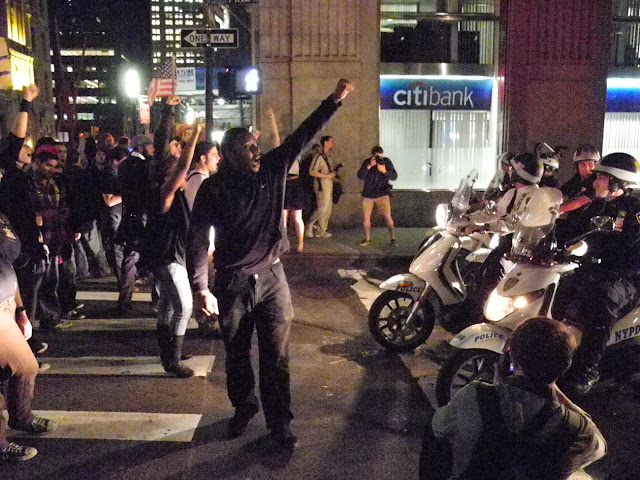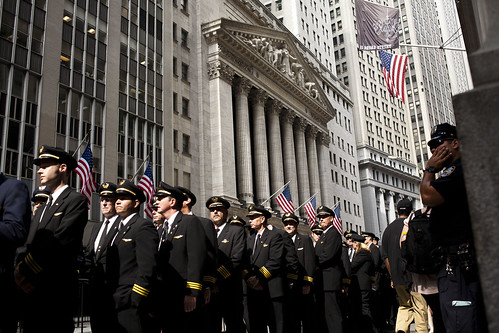George Mason University
The U.S. census recentlyreported that the incomegap between the richest and the poorest in the United States has doubledsince 1968 (from a ratio of 7.69 to 1 to 14.5-to-1 in 2010), the United Statesis currently active in not one butthree major wars, and there are more black men in American prisonstoday than there were slaves in 1850. You don’t need a crystal ball, or a giant granite one, to know MartinLuther King’s response to this condition.
In spite of the justifiable andtouching power the new Martin Luther KingMemorial on the National Mall in D.C. takes from our nostalgia for theCivil Rights Movement of the 1960s, it fails to move us any closer tounderstanding or realizing how a living monument to King's dream requires ourresistance to militaristic and economic forms of oppression. The Memorial whitewashes any sense of King asactivist, disrupter of power structures, and critic of economic systems. It hides the struggle demanded by King.
A figural 30 ft-tall sculptureof MLK emerges partially formed from a block of granite, called The Stone ofHope, which appears to be the middle third of a giant boulder, sliced out andpushed from between the other two slabs of rock—The Mountain of Despair—towardsthe tidal basin on the National Mall. The colossal white granite memorial, located at the cartoonish addressof 1964 Independence Ave., SW DC, sternly faces the Jefferson Memorial, withits back towards the Lincoln.
None of the fourteen quotationscarved into the wide marble wall that arcs around and behind the statue of Kingrefers directly to King's work against economic injustice. One quotation, from his Nobel Prizeacceptance speech, does suggest the audacity of his desire that all peoplereceive three meals a day. Unfortunately, this phrase becomes a touching platitude when removedfrom demands for state action or public policy. The architect carved two additional quotations onto the sides of thestatue of King, including one that has provoked significant criticism in whichKing appears to be describing himself as a “drum major for justice.”
King’s original quotation suggested that hedidn’t mind being deprecated in the service of the cause even if critics wantedto call him a “drum major for justice.” Exactly the meaning suggested by the redaction; Maya Angelou said thatedit made King look like an "arroganttwit." The Foundation missedthe point, but, worse, they missed an opportunity and wasted valuable spacewith a clichéd phrase, when King authored so many pithy statements ofpurpose. King's remarks, for example,concerning the seat of the national government are remarkably appropriate fordisplay in Washington DC: “We will placethe problems of the poor at the seat of government of the wealthiest nation inthe history of mankind.” The statementsdisplayed on the memorial fail to provide much meaning to King’s vision, evenas they strategically lack any reference to his economic demands.
This shouldn’t be toosurprising. In spite of their repeatedattempts to destroy organized labor, suppress wages, and general success atshifting wealth to the very rich, major corporations paid for thismemorial. Coke, Ford, Target,ExxonMobil, BP, FannieMae, JPMorgan Chase @ Co., NFL, McDonalds, and LehmanBrothers all donated to the Memorial and are listed on the majorcontributors page. General Motorsdonated $10 million. Wall-Mart gave $1million. The Foundation proudly proclaims the faith these major donors have inKing’s dream. “By their generoussupport,” the website proclaims, “they’ve demonstrated something trulyremarkable. They’ve shown the breadth ofsupport that exists for Dr. King’s vision, from the man on the street toboardrooms on the fiftieth floor.”
Thoseboardrooms, high above the people occupying the street, did not offer large donationsin order to memorialize the fact that King was assassinated in 1968 while inMemphis supporting striking sanitation workers; that just days after herhusband’s murder Coretta Scott King and 42,000 people peacefully marchedthrough Memphis to demand that the Mayor of Memphis recognize the sanitationworker’s union; that at the time of his assassination King was hard at work onthe Poor People’s Campaign. Neither Walmart nor Target,companies that have dedicated massive financial resources to fighting laborunions, could be expected to memorialize King’s vision for the power oforganized labor. Certainly not Coke, with its history of fighting unions inGuatemala and accusations that the company has used prison labor in China, andits probable complicity in the death of union organizers in Columbia. These donors, I claim, paid for a Memorialthat would help us forget that the revolution, as GilScott-Heron sang, "does not go better with Coke." They got what they paid for; the Memorialdoes not offer any sense of the stern criticism King would certainly directtoward the labor practices of many of these companies. The problem is not that they gave money forthe Memorial, it’s that the Memorial fails to display the conflict thosedonations have with King’s labor advocacy. “We call our demonstration acampaign for jobs and income,” King wrote, “because we feel that the economicquestion is the most crucial that black people, and poor people generally, areconfronting.” (A Testament of Hope: The Essential Writingsand Speeches of Martin Luther King Jr., Pages 67-69) Simply allowing the Memorial todeliver King’s message concerning the importance of organized labor on amonument paid for by labor busters would offer a better representation of thestruggle that King advocated.
Corporations were not the onlydonors, nor were they the only donors with labor policies in serious conflictwith King's struggle. The Memorial, asmany have remarked, was created in China. The Chinese government, probably the largestsingle donor to the memorial, gave the foundation $25 million--the U.S.government only gave $10 million in matching funds. The Foundation naively denies that theChinese donation influenced their decision to create the memorial inChina. Union representatives in theUnited States protested the contract with China and eventually received apromise from Johnson that union labor would be used to assemble the monument inthe United States. Then in September oflast year, the union discovered that the Foundation had reneged on this writtenpromise and that unpaid workers from China were working on the Memorial. Harry S. Johnson, president and CEO of theMemorial Foundation, evoked a hypocritical claim toracial harmony to hide the issue of economic exploitation. On September 8, theFoundation asserted: “While 95% of thework is being done by American workers, we strongly believe that we should notexclude anyone from working on this project simply because of their religious beliefs,social background or country of origin.”
TheFoundation consistently gestured toward pluralism and artistic integrity tomake the exploitative dimension of their economic choices disappear. According to Ed Jackson Jr., the ExecutiveArchitect on the project: “The granitefor King's statue was chosen because when lit at night, it lends a brownishtone to King's likeness. The stone, however, only exists in China.” though, headded, “some wanted it to come from the United States.” All the white marble on the National Mall,whether from China, Italy or New Hampshire, gets darker when the sun goesdown. Jackson’s ridiculous claim aboutthe color of the statue raises another, more obvious, question: why not use black granite? Martin Luther Kingwas Black.
 |
| Birmingham, Alabama King Memorial |
Theassertion, given broad currency in the 1960s, that “black is beautiful”highlights a politics of aesthetic taste. The color and shape of the statue ofKing appears as a visual and sensual event. The body with its attractions (ofcolor, shape, size, strength, weakness, etc.) functions as a political triggerfor desire and emulation. Plenty of ourresponses to the appearance of the human body are beyond and before ourunderstanding of actions, arguments, and behaviors. Such responses are animportant part of our political life. Monuments operate in this field. King’s physical appearance moves us; King deserved a monument that wouldmove us.
 |
| Binghamton, New York King Memorial |
Itis inescapably necessary to represent King in earlier categories of power andvalue but the valuable struggle comes in using that positioning to undercut theborrowed hierarchy. Borrow the trappings of power but only to transform theterms of success. Take some money from Coke but spend that money to support theColumbian food workers union, SINALTRAINAL. This Memorial fails because it never displaysthe struggle necessary for political life. King’s life was a life of this struggle.
 |
| King's arrest for 'loitering,' 1958 |















































